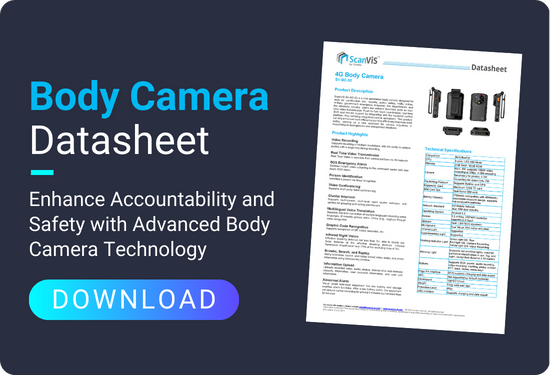ScanViS
Data center physical security features: How IoT-enabled solutions help?
- Details
- Written by ScanViS Team
- Category: Blog
- Hits: 6111
Security is the core to the success of data centers. Both physical and cybersecurity measures should be considered and implemented to form interlocking protection. The deployment of Edge Data Centers (EDC) and enhancement of cloud-based video analytics contributed to the growth of the data center physical security market, with market revenue expected to grow at a CAGR of 4% from 2020 to 2025. [1]
To prepare for the post-pandemic era, 70% of IT managers agreed that the “new normal” has increased the urgency for organizations to adopt ACaaS (Access Control as a Service) and/or VSaaS (Video Surveillance as a Service). [2]
Access Control as a Service (ACaaS)
ACaaS leverages on-premises access control devices with cloud computing systems. It allows flexible, scalable management with all access logs stored at remote servers. With a central management system, users can monitor entry points of multiple locations and automate attendance recording.
With ACaaS, end-users no longer need internal IT departments to build up and maintain the servers and infrastructure at the business facility, which incurs more upfront Capital Expenditure (CAPEX). With cloud-based solutions, onsite servers and appliances can be eliminated to reduce the total cost of ownership while not losing any functionality.
Video Surveillance as a Service (VSaaS)
Video surveillance systems control multiple sources of video subsystems in a facility to collect, manage and present video clearly and concisely. Through VSaaS, users have a one-stop solution for end-to-end implementation of video surveillance solutions with options to retain information in central cloud storage.
VSaaS can offer a unique public, private, or hybrid cloud environment with real-time management and monitoring capabilities, built-in analytics, cloud-based economic models, and deployments verified at scale in multinational or enterprise companies around the world. Thanks to its increased flexibility and reduction in running cost, the market for network-based video security systems is growing globally year by year.
IoT-enabled physical security features for data centers
Dealing with data breach threats, data centers need a holistic security solution to protect corporate data from perimeter to server racks. With cloud-based ACaaS and VCaaS solutions, security measures will be carried out in a more efficient way to keep data assets safer.
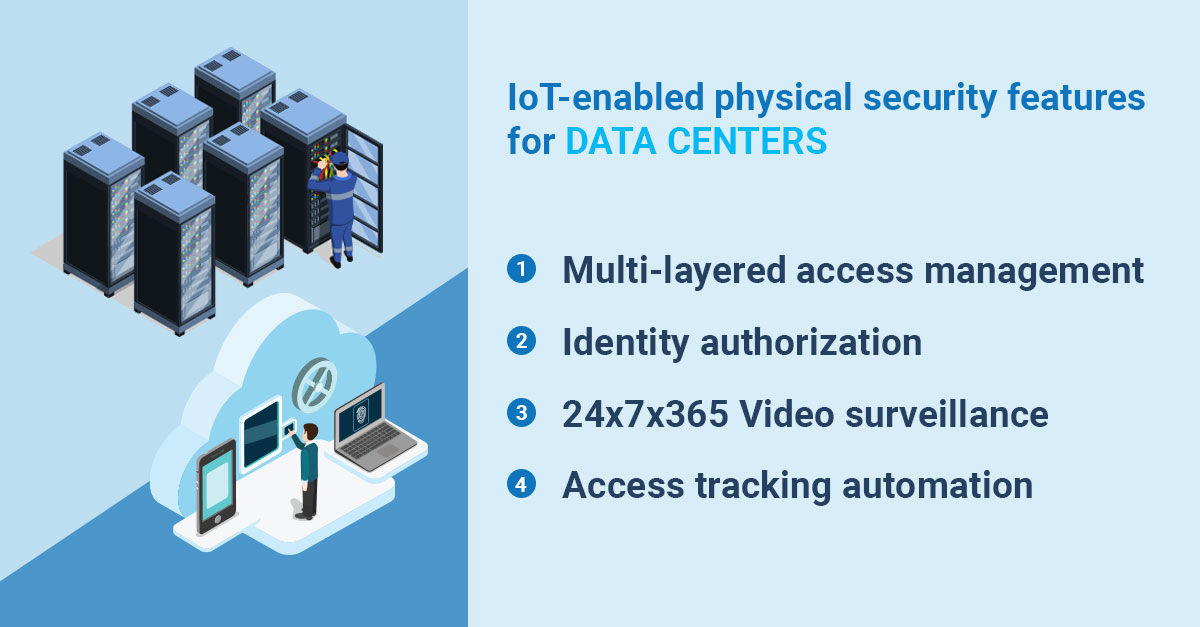
1. Multi-layered access management
Since access to data centers is restricted to people within the organization that can be admitted to work with particular servers and hardware, access control management needs to be clear and efficient across various zones.
Rack-level security could be improved with network-enabled server locks. By segmenting access for various levels of users, server locks can be opened for specific sets of time by specific personnel.
The backend system of ACaaS requires up-to-date access lists to ensure which user has legitimate needs to reach server racks.
2. Identity authorization
To follow the “zero trusts” approach and meet the highest security requirements, data centers need to incorporate an accurate, reliable multi-factor authentication system (MFA).
Biometric identification has become more prevalent, expanding to wider proliferation as a method of entry. Especially in a pandemic, advanced facial recognition technology provides a touchless solution to control physical access when installed on doors and gates. ACaaS centralizes the management of access control devices. Faces and ID groups can be synchronized to the cloud. It allows security managers to set different user groups and specific access times.
Additional verification mechanisms add next-level security within the data center. Visitors may also be given a password or RFID card on top of biometrics authentication. As a result of implementing multi-factor authentication, the risk of identity theft or fraud can be reduced. Aside from preventing a data breach, enhanced authentication technology helps build up user experience as well.
3. 24x7x365 Video surveillance
Remote video surveillance is essential to nearly every industry, especially data centers.
Cloud-based video security systems handle every aspect from IP cameras and sensors management to video storage and server maintenance. All footage is digitally stored for future review, increasing the flexibility of security management.
VSaaS enhances the scalability of simultaneous location monitoring from one portal. This feature allows off-site security managers to remotely survey live videos from multiple angles and control the devices in a different location.
Integrated with temperature scanning technology, video surveillance systems can identify hot/cold spots and issue alerts whenever a temperature event within the server room occurs.
4. Access tracking automation
Industry institute report found out 30% of data breaches were attributed to internal users.[3] Keeping track of who and when accessed each server rack is necessary for data center security management.
Electronic Access Solutions (EAS) capture “sign” for each access attempt. Real-time alerts will be sent when unusual access attempts are detected.
Automated with ACaaS, access reports will be auto-generated periodically. Tracking historical access logs became easier and efficient when ACaaS is integrated with VSaaS, security managers can select to watch particular video playback without viewing the whole footage.
Conclusion
After an early analysis of the business implications of the pandemic and its induced economic crisis, a recent industry report indicates the demand for ACaaS is escalating, with an estimation of its global market size to reach US$3 Billion by 2027[4]. On the other hand, the global market for VSaaS is projected to reach a revised size of US$10 Billion by 2027 from US$3 Billion in 2020, and growth in the Managed segment is readjusted to a revised 17.3% CAGR for the next 7-year period.[5] These figures might be further pushed up in the post-pandemic era to show an increasing demand for a higher level of physical security in the markets.
“By 2025, 85% of infrastructure strategies will integrate on-premises, colocation, cloud, and edge delivery options, compared with 20% in 2020.” (Gartner Research Report 2020)
All these illustrate cloud-based security systems are expected to grow in wider applications, including enterprise data centers, clinical research data warehouses, education data centers, and more.
References
[1] Data Center Physical Security - Global Outlook and Forecast 2020-2025, https://www.researchandmarkets.com/reports/5214683/data-center-physical-security-global-outlook
[2] The impact of COVID-19 on cloud adoption and the implications for the physical security industry, Hosted Security Landscape Report 2020/21, https://morphean.com/whitepaper/White%20Paper%202020_EN.pdf
[3] What Is Data Center Security? 6 Ways to Ensure Your Interests Are Protected, https://www.thesslstore.com/blog/what-is-data-center-security-6-ways-to-ensure-your-interests-are-protected/
[4] Market Impact Survey - Covid-19 & Looming Recession, Global Access Control as a Service (ACaaS) Industry, https://www.reportlinker.com/p03704490/Global-Access-Control-as-a-Service-ACaaS-Industry.html
[5] Video Surveillance As A Service (VSaaS) - Global Market Trajectory & Analytics, https://www.researchandmarkets.com/reports/3440918/video-surveillance-as-a-service-vsaas-global
How can organizations best prepare to safely reopen businesses and remain open?
- Details
- Written by Ricky Tsui
- Category: Blog
- Hits: 2353
Today, social distancing has changed the way we go to work, shop, and even the types of jobs are deemed essential. Companies have been forced to completely alter their business practices, and there has been a push to innovate new tools to help understand, navigate, and stop the spread of this pandemic.
Workplaces and commercial areas, no matter offices, warehouses, retails or F&B services, are prime locations for viruses like COVID-19 to spread. Many businesses require a major shift in coronavirus office or venue policies, for example, including thermal detection and mask wearing in the premises. While some are now operating with minimal staffing or a fully remote workforce, meaning drastic changes to who has building access, and how employees are coming and going.
More and more organizations prefer automatic door controller alongside readers and software as a fully automatic access control system can offer teams a touchless, germ-free, and frictionless entry experience, protecting them from cross infection.
In addition, transitioning to a cloud managed access control system also makes site management simpler and safer, without relying on on-site personnel. When it comes to updating for coronavirus building security, a system that can be managed remotely offers greater control and flexibility:
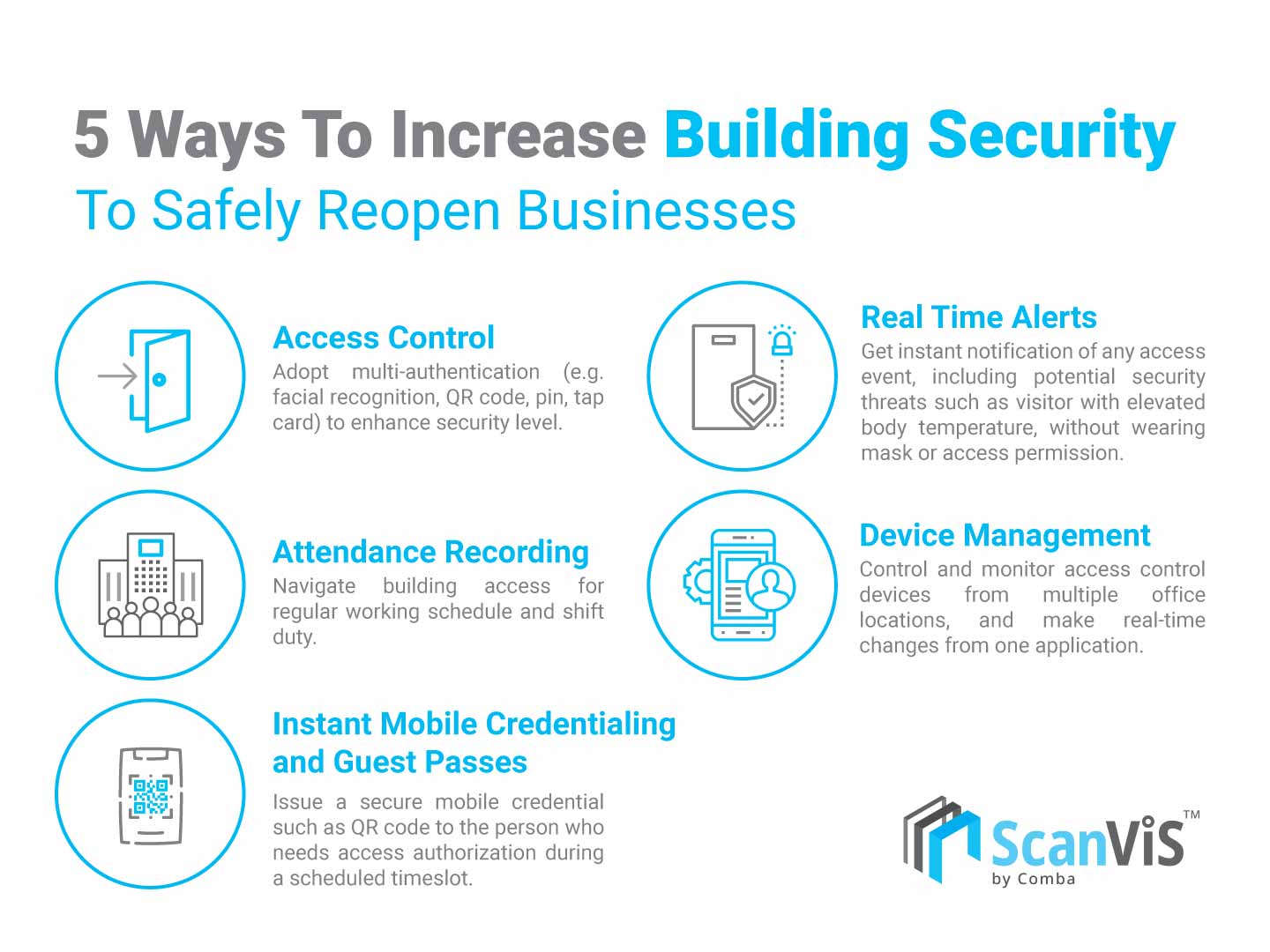
Access control - adopt multi-authentication (e.g. facial recognition, QR code, pin, tap card) to ensure access authorization to the right person and enhance security level.
Attendance recording - navigate building access for regular working schedule and shift duty.
Instant mobile credentialing and guest passes - issue a secure mobile credential such as QR code to the person who needs access authorization during a scheduled timeslot (e.g. visitors, vendors).
Real time alerts - Get instant notification of any access event, including potential security threats such as visitor with elevated body temperature, without wearing mask or access permission.
Device management – control and monitor access control devices from multiple office locations, and make real-time changes from one application.
As the world begins to normalize again, a customized access control solution can help organizations reopen their doors to their employees and to the public. Whether they building a complete access control solution from the ground up, or if they have a legacy system in place already and just want to add the cloud and mobile capabilities on top of it as an upgrade. Their access control system should be just as flexible, resilient, and future-proof as the population of people it is designed to protect. Under this consideration, health and hygiene will take a much higher priority.
Body Camera
- Details
- Written by Super User
- Category: Products
- Hits: 547
- Product Image:

Enhance Accountability and Safety with Advanced Body Camera Technology
Designed for a range of applications, including law enforcement, security, and emergency response, the body camera represents a crucial innovation in maintaining transparency and safety in high-stakes environments.
Equipped with cutting-edge technology, modern body cameras offer exceptional video quality, real-time streaming capabilities, and robust data management features. These devices capture high-definition audio and video, ensuring every interaction is documented accurately, which is essential for accountability and evidence collection.
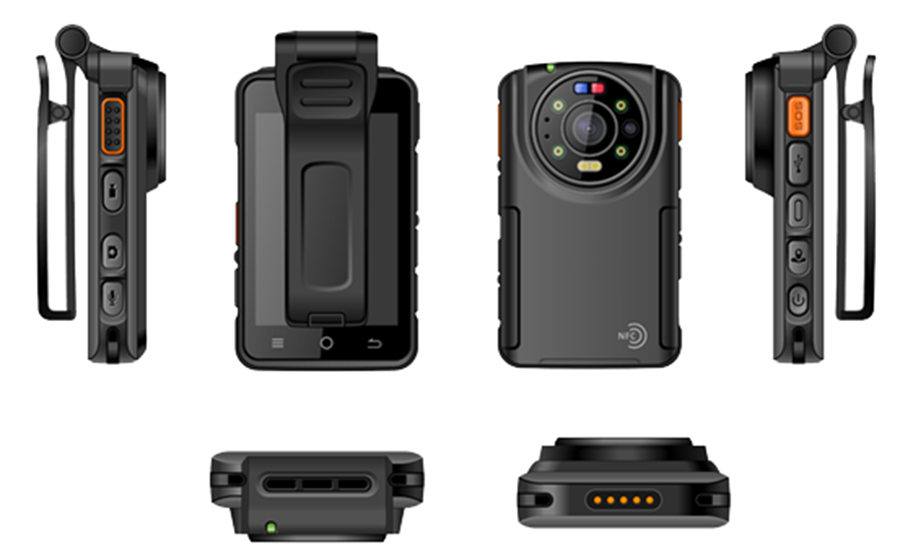
Tracking Camera
- Details
- Written by Super User
- Category: Products
- Hits: 2759
- Product Image:

Achieve Flawless Precision with the Ultimate Auto-Tracking Camera
Tailored for professionals in need of high-quality video tracking, ScanViS has developed the Education Intelligent Auto-Tracking Camera product line - an exceptional innovation.
The ScanViS Tracking Camera is built-in with a high-speed processor and advanced image processing and analysis algorithms. It automatically tracks lecturers and students accurately and quickly, ensuring they remain consistently in focus throughout their presentations, eliminating the need for manual adjustments and providing a seamless viewing experience. This meets the requirements of lecturer capture and remote interactive teaching.
Powered by advanced Digital Solution Processing (DSP) technology and sophisticated algorithms, the ScanViS Tracking Camera produces lifelike images characterized by vivid colors, uniform screen brightness, and superior definition. You can rely on this camera to faithfully reproduce accurate colors and maintain excellent light and color layering, resulting in a captivating visual experience.
The main products in this series are the SV-EPTZ100T and SV-EPTZ430V Education Intelligent Auto-Tracking Cameras. The SV-EPTZ100T is a basic model designed to meet the precise requirements of hosting webinars, delivering lectures, and conducting professional presentations. The SV-EPTZ430V, on the other hand, features impressive UHD 4K capabilities, equipped with a wide range of outstanding lenses, offering higher quality visual detail. Both cameras enable viewers to immerse themselves in the content as if they were physically present in the room.
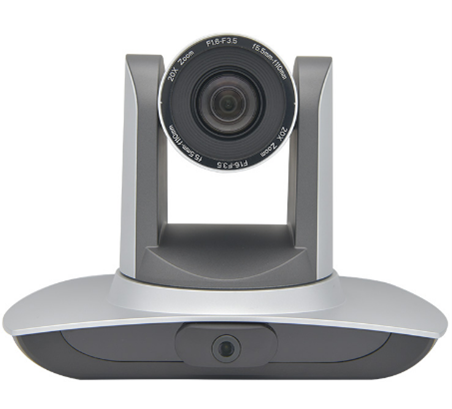 |
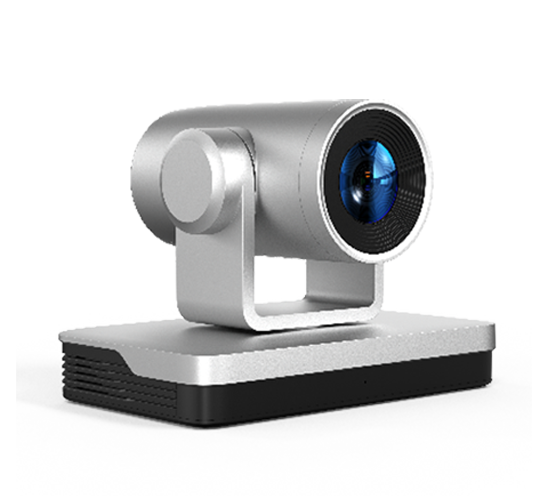 |
| SV-EPTZ100T | SV-EPTZ430V |
Page 6 of 16
